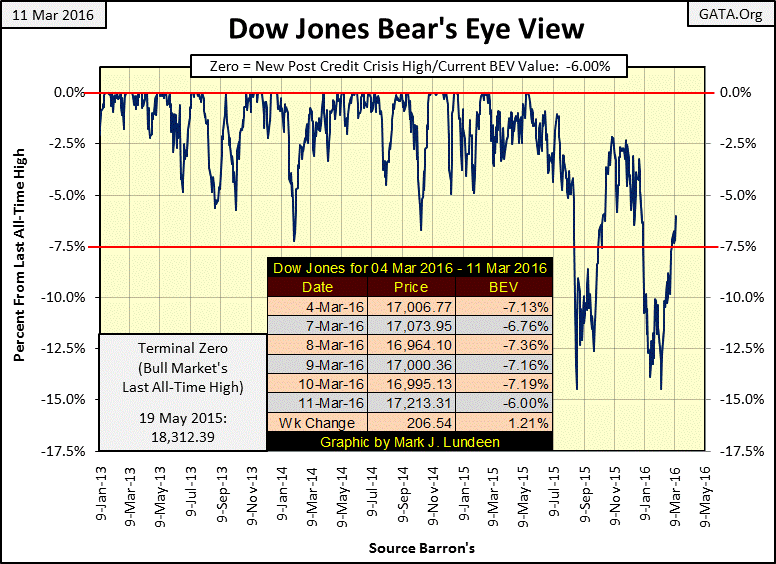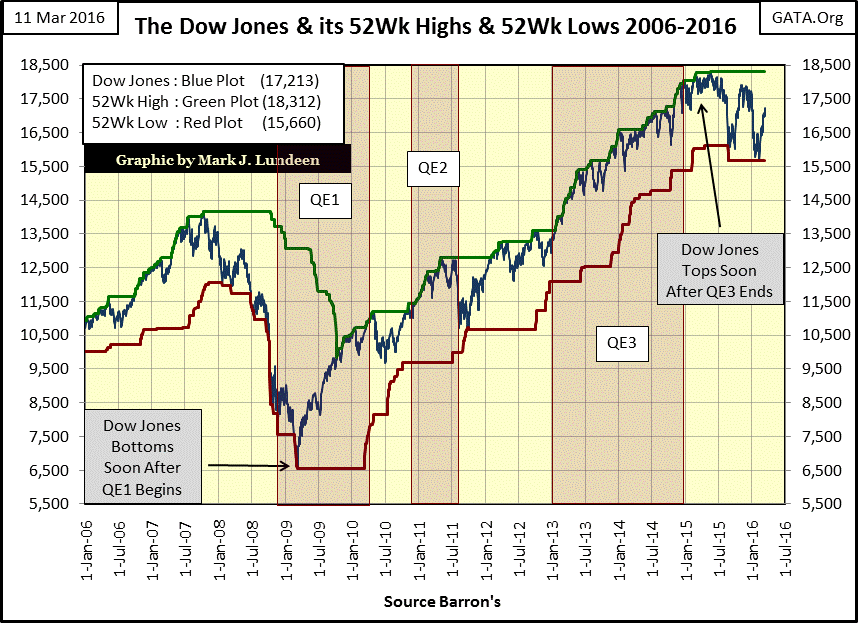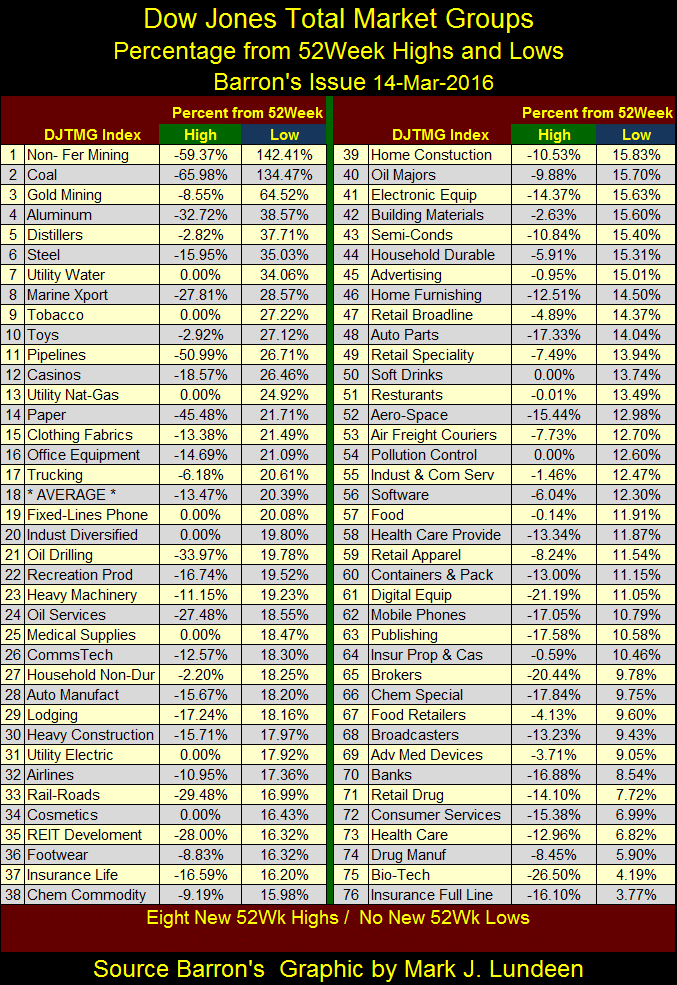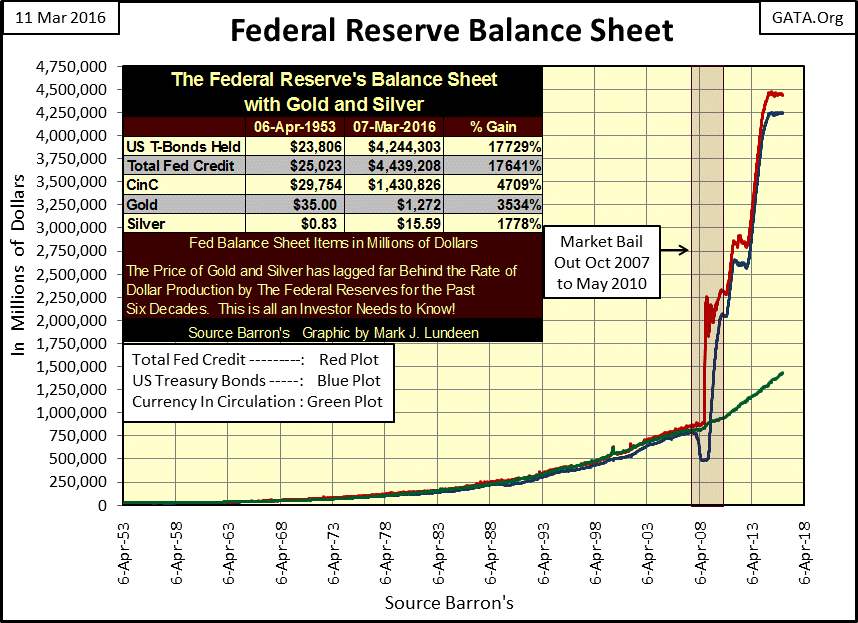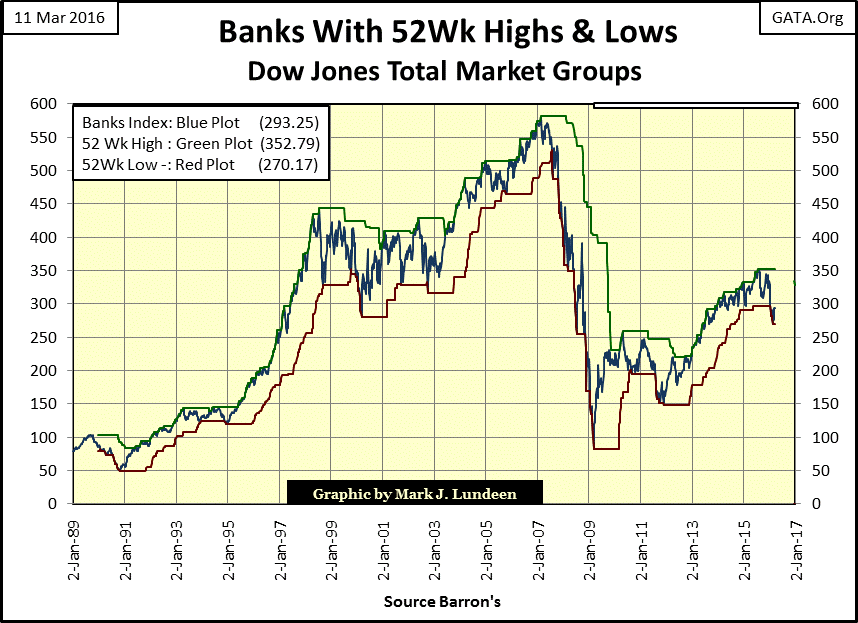The Dow Is Just 6% From Another All-Time High…But Banking Stocks are 100% Away From One
How’s the bear market going? Haven’t you’ve heard? Nothing but blue skies and sunshine ahead as far as the eye can see. Hard to believe, yes, but I still can’t argue that the stock market hasn’t been performing better than it was in January. Mr Bear was docile last week; no days of extreme market breadth or volatility to report, and the Dow Jones (below) is trending back toward its BEV -5% line. Even so, the Dow Jones still needs 1,100 more points to make a new all-time high (the Red 0.0% Line). Can it? Sure it’s possible. But I suspect the next eleven hundred points will be more difficult than the past fifteen hundred it’s advanced since it’s last 52Wk Low on February 11th.
Next we see the Dow Jones plotted with its 52Wk Highs and Lows. One could argue that the difficulties in the stock market since last May are merely a correction within a larger bull market. But one would have to ignore completely the fact that since the credit crisis the Dow Jones has only advanced in response to three episodes of Quantitative Easing. Okay, since February 11th the Dow has managed to advance toward a new all-time high without the benefit of any quantitative easing from the Fed. But since last May it’s also seen not one but two twelve percent corrections, but no new all-time highs.
I still say it’s the bulls that bear the burden of proving we are still in a bull market. I can’t see into the future, and Janet Yellen stopped taking my phone calls after she became Chairwoman of the Fed. But as you’ll see later in this article there are lots of problems in the economy and financial markets. So to my way of thinking it’s more likely we’ll see the Dow Jones drop below 5,000 (a 70% bear market) before we see it above 19,000.
The Dow Jones Total Market Group (DJTMG)’s Top 20 (the number of groups within 20% of their last all-time high) ended the week at 41, a big improvement from Barron’s 18 January 2016 issue when there were only 26. But can the Top 20 manage to exceed the post credit crisis peak of 52 from back in July 2014? Anything could happen. But since 1992 it seems to peak when the stock market is inflating (as it did during the High Tech and Mortgage bubbles), and then begins to deflate until, during the credit crisis, there were no groups left within 20% of their last all-time high. I expect the top seen in July 2014 will prove to be the post credit crisis bubble peak in DJTMG’s Top 20.
Something interesting is happening in the DJTMG 52Wk High and Low data. In the table below I sorted the groups by their Blue 52Wk Low column. #1 & #2 have seen huge declines from their 52Wk Highs, but they’ve more than doubled since their January bottoms just a few weeks ago. Non-Ferrous Mining bottomed 82% below its 52Wk High in Barron’s January 25th issue, but then bounced back more than 140% in just six weeks. Coal bottomed 87% below its 52Wk High in Barron’s January 18th issue, then bounced back more than 130% in just eight weeks.
However, looking at the huge percentage declines in Non-Ferrous Mining and Coal since their 52Wk highs leads me to believe that these gains are just dead cat bounces – not long term trends. Obama famously promised to destroy coal mining as an industry. With his EPA motivating many electric power utilities to switch from coal to natural gas I’d say he was successful. And I doubt that base-metal mining has much potential to recover unless China once again begins to expand. China currently is capable of producing more than a billion tons of steel annually. They could sheath their Great Wall with Steel if they wanted too, or go broke trying to sell hundreds of millions of tons of steel no one has any use for.
Which takes us to #3 below: Gold Mining may have advanced a huge 64.5% since its 52Wk Low (as of Barron’s January 25th issue), but it’s currently just 8.55% away from a new 52Wk High. After a brutal bear market that began back in August 2011, it looks like the precious metal miners have turned the corner and may be entering a multi-year bull market. And unlike Coal or Non-Ferrous Mining, there is never lack of global demand for the gold and silver these miners pull from the ground. I like the PM miners.
Decades ago unless a change was announced in the Discount Rate, investors seldom read anything about the Federal Reserve. People might be excused for not knowing the United States even had a central bank for what little the media said about it. All that changed in the late 1970s when Fed Chairman Paul Volcker levitated short term rates into the double digits, far above long term bond yields. This is known as a “yield inversion.”
In the late 70s and early 80s for the first time the Federal Reserve received much media attention when Volcker testified before Congress. He knew his inflation fighting policies were causing lots of pain but he didn’t care because that’s what the doctor ordered. “So you see Mr. American Voter, the recession wasn’t Congress’s fault; it was that Volcker guy.” Now you see why Chairmen of the Federal Reserve are appointed, not elected.
Who among us doesn’t hear that the Federal Reserve has the solution for all that ails the economy? Does a week ever go by without a member of the FOMC giving the public insight into “Fed policy?” Stanley Fischer on Monday told CNNMoney that the FOMC will soon meet its 2% inflation target.
The Fed's No. 2, Stanley Fischer, spoke optimistically about a key yardstick for the economy. He noted that a recent pick-up in inflation could currently be moving up towards the Fed's 2% target. --- Comments like Fischer's suggest the Fed is gaining confidence about its two key measures; inflation near 2% and a strong job market. Many Fed officials have said the job market is at or near "full employment." The unemployment rate is 4.9%.
- CNNMoney (New York) First published March 7, 2016: 2:54 PM ET
Before 1971, if it was announced that inflation had fallen below 2% and that the FOMC was optimistic that it could correct this “problem” it would have been quite a hoot! And what’s all this about the job market nearing full employment? CNNMoney, like most legacy media outlets are captured by the Washington establishment. They’re not going to mention the current inability of many college graduates to find employment in their field, or embarrass a member of the FOMC by mentioning that their personal grocery bills have risen far more than 2% over the past year.
Let’s take a look at what the Federal Reserve has been doing over the past few years to elevate “inflation” above 2%. They’ve expanded their balance sheet by more than 400% since August 2008. Obviously, in order to achieve their 2% inflation goal a new round of QE will be soon required. Cutting through the “policy” BS, members of the Federal Reserve couldn’t care less if inflation fell below 2% - which it hasn’t. Their actual concern is that a significant portion of the debt market they’ve inflated (using open market operations) is at risk of, or has already gone into default. When it does they fear it will take everything else down with it, along with their credibility in the financial markets and in the halls-of-power in Washington.
Here’s the problem, and it’s been a long time coming: when one goes into a bank for a loan, the first thing the bank wants to know is how much debt you’re carrying. If the loan applicant has no debt, they get a better rate than someone with a mortgage and car loan to pay off. Maybe they’ll even refuse to lend to someone if their current debt load is too high. The banker isn’t being vindictive; it’s just their way of rooting out deeply indebted clients living beyond their means.
But the “policy makers” like to think they’re above the bounds of natural laws such as not being possible to live beyond one’s means forever.
Below we see how the US National Debt has progressed from 1953 to present. I placed the yield for the US Treasury long bond at a few key points along the chart. The first data point has the US National Debt at 267 billion dollars, with the yield on the long bond at 2.71%. A national debt of two hundred and sixty seven billion dollars may seem small now, but sixty years ago it was a cause of concern. Three decades later, just months before the national debt first broke above one trillion dollars the long bond yield soared to 15.04%. This was the market’s way of telling the US Government it had been spending other people’s money too freely and the bond-market vigilantes feared a pending Treasury default.
But ever since 1981, T-bond yields have been declining while the national debt has surged. Just last month the national debt climbed above nineteen trillion dollars while treasury bond yield’s broke below December 1952 levels. How is that possible? Former Fed Governor Warsh told the WSJ how.
"The policy makers are finding it tempting to pursue 'financial repression' -- suppressing market prices that they don't like." He added, "Efforts to manage and manipulate asset prices are not new."
- Fed Governor Kevin M. Warsh, Wall Street Journal Quote
Former Fed Governor Warsh more specific at Stanford University back in 2012.
"Now that I am out of government, I can tell you what I really believe.
- Central banks are now so heavily influencing asset prices that investors are unable to ascertain market values. This influence is especially evident, with the Fed's purchase of government bonds, which has made it impossible for investors to use bond prices to learn anything about markets.
(This is how bond yields today can actually be lower than in 1952; using inflationary funding the Federal Reserve purchases US Treasury Debt at any price with no regard to the solvency of the issuer whose debt burden now exceeds nineteen trillion dollars. Mr. Warsh continues.)
- The government-sponsored housing entities remain sources of vulnerability to the U.S. economy, and repeated ad-hoc attempts to push Fannie Mae and Freddie Mac to take greater risks at taxpayer expense are deeply counterproductive. Such efforts have not succeeded”
- Kevin M. Warsh: Former Federal Reserve Governor. Comments made to the Stanford University Institute for Economic Policy Research, 25 Jan 2012.
Just four years after the credit crisis, the “policy makers” were busy inflating yet another bubble in real estate. It’s obvious that the “policy makers” solutions are the cause of the problems we struggle with today, and have for a long time. Ground Zero for this mess is the banking system.
"Market participants, for example, need a clearer, better understanding of large financial institutions to be good policemen themselves. But the financial statements, the annual reports, the 10Ks, the 10Qs of the largest banks around the world tell us so little about their true risks. If you spend a few hours reading the financial statements of Wal-Mart or Proctor & Gamble, then you would understand their business and financial statements reasonably well. It is virtually impossible to do so for the largest global banks."
- Kevin M. Warsh, member of the Federal Reserve Board of Governors February, 2006 – March, 2011. Quote from May 2011 issue of Central Banking (pages 32-40)
If the banking system, or their government regulators wanted investors to know how sound the banking system is, they could do so in their accounting. They don’t because the banks and their government regulators have much to hide, and that also goes for the Federal Reserve. They are the controlling bank that is never subject to public audit.
I’ve said in the past that the key to the future of the Dow Jones (and the stock market), was the banking stocks, so here’s the DJTMG’s Banking Index plotted with its 52Wk Highs and Lows (#70 in the DJTMG table above). Remember, these companies were ground zero for the credit crisis, a crisis that spread far beyond Wall Street. Banks provide the global economy with its payment system. When the banking system breaks down – so does everything else.
If you take a moment to compare the Banks with their 52Wk plots below with the Dow Jones chart above, you’ll see there is quite a difference. For one thing, unlike the Dow Jones, all three programs of quantitative easing did little to lift the bank’s share prices, even though banks have been widely recommended for years by the clueless financial media.
That’s a big red flag, as the only reason the Federal Reserve even conducted these three QE programs was to assist these companies. For investors in banking stocks that’s not much of a return considering the many trillions of dollars in assistance.
Let’s go a little deeper and compare the Dow Jones with the banking stocks’ 52Wk Highs and Lows . The Dow Jones’ 52Wk High (table below) is also its last all-time high, from which it is currently only 6% away. The DJTMG Banking Index’s last all-time high was back in 2007. It now sits 50% below that level, and would take a 100% gain to reach it again. It’s currently 17% below its 52Wk High.
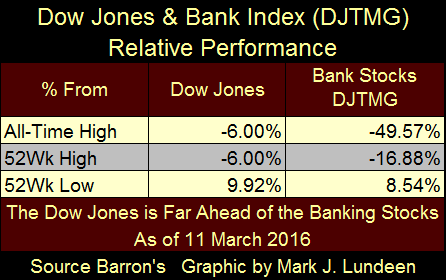
As far as their advances from their 52Wk lows of a few weeks ago, they have both seen solid advances. But the gold miners have done much better, and should continue to do so for years to come.







